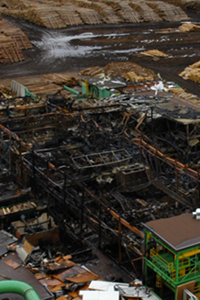Explosion and fire at sawmill in Prince George
Date of incident: April 2012
Notice of incident number: 2012136900086
Employer: Lakeland Mills Ltd.
Incident summary
The afternoon shift at the Lakeland sawmill was taking its lunch break. Workers were in various areas of the sawmill and in the mill's two lunchrooms. The northeast corner of the sawmill exploded outward; a few seconds later, the mill's northern baghouse erupted in flames. The explosion travelled east to west through the operating level of the sawmill and collapsed the main lunchroom walls onto the workers assembled there. Workers in the basement-level millwright's lunchroom were blown out through the south wall by the force of the explosion. The sawmill caught fire as a result of the explosion and was destroyed. Two workers died as a result of their injuries, and 22 others were injured.
Investigation conclusions
Causes
- Concentration of dispersed wood dust in the air: The wood dust that was dispersed in the air within the Lakeland sawmill was of sufficient concentration to explode. The wood dust was the fuel for the explosion.
- Friction in gear reducer provided ignition source for wood dust explosion: Near the gear reducer was a containment zone created by a high-walled conveyor, a steel-plated ceiling, and an exterior wall. The spring sleeve that held the fan on the gear reducer's worm gear-shaft had failed, and the fan became free and travelled along the shaft. When the fan reached the shaft end, it became embedded in the steel screen, grinding into it and coming to a stop. The fan remained in this position while the shaft continued to rotate at 1,750 rpm. The rotating shaft generated frictional heat, reaching a temperature of approximately 577°C. The airborne wood dust deflagrated in the containment zone for the primary explosion. The resulting secondary explosions and fire destroyed the mill, leaving two workers dead and 22 other workers injured, many seriously.
- Lack of a dust collection system and ineffective dust control measures: Dust control measures were ineffective in the slasher and debarker areas, the dustiest areas of the sawmill, along with the areas beneath this equipment in the basement level. Dust removal in these areas was dependent on natural airflow, as there was no dust collection system and the water misting system was not operational or was ineffective. Suction hoods and collection ducting for the dust collection system reached only as far as the large headrig and the waste conveyor below it. Closed doors and tripped abort gates resulted in lack of makeup air, and the effectiveness of the dust collection system was compromised. Lakeland constructed a new sorter line to better handle the lumber but did not install waste conveyors for it. The mill decided to have the sorter in operation and then construct residual conveyors. This resulted in excessive amounts of wood waste being dropped onto floors and walkways that had to be manually removed daily by wheelbarrow. This task became a priority for clean-up workers, and clean-up in the rest of the sawmill suffered as a result.
- Ineffective maintenance and inspection of the sawmill gear reducers: There was no regular inspection or maintenance of the gear-reducer cooling fans. The fan shroud is designed with a small opening through which to view the interior with the cooling fan. This opening is guarded with an expanded metal screen. In the gear reducers reviewed at this mill, the screens were saturated with oily wood waste debris and the interior could not be viewed effectively. WorkSafeBC did not investigate the circumstances that resulted in all of these seal leakages, but the number found in this condition is troublesome. The apparently routine findings that these cooling fans were not secured and/or were sitting on a rotating gear-shaft are also concerning. Failure of the spring sleeve was due to cyclic loading. This gear reducer was subjected to the following conditions: constant stopping, starting, fluctuating conveyor loads, temperature changes, shock loading, and vibration. The fact that the millwright department had often found these fans unsecured should have prompted preventive maintenance or an upgrade to a better suited gear reducer.
- Waste conveyor configurations increased airborne wood dust: Waste conveyors in the basement level did not adequately capture the fine dust generated during lumber processing. These conveyors were open to the operating floor above and there were large open areas along the conveyor sidewalls. Wood waste was dropped from one conveyor to another, accompanied by vibration in some cases. Conveyors were not equipped with an effective dust collection system. Fine wood dust stirred up by the constant action of the conveyors was free to disperse into the air. Lakeland installed dust collection ducting for some of the conveyors but not for others. Even where such ducting was installed, the fine dust was not effectively captured. This fine dust should have been removed independent of the waste conveyor system.
- Conditions of the wood and weather: Weather conditions resulted in a very dry environment with low humidity. This condition was compounded by the very dry beetle-killed wood. The dusts produced were drier and finer and they migrated throughout the mill. These dusts were mixed with green wood dusts as green wood was being processed concurrently. The very dry environment, low humidity, and dust conditions contributed to this incident.
- Inadequate supervision of clean-up and maintenance staff: The accumulations of wood waste before the explosion and the poor condition of some of the electrical equipment that was inspected after the incident indicate that supervisors were not effectively or adequately monitoring the clean-up work.

